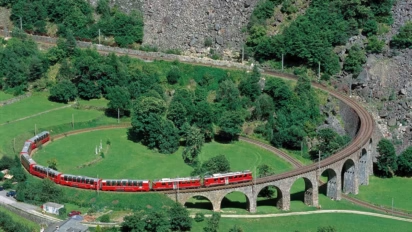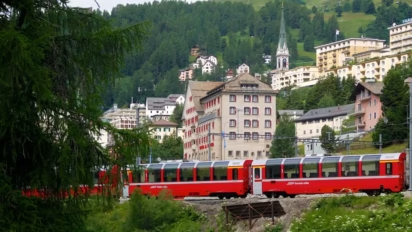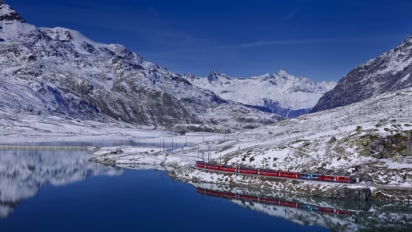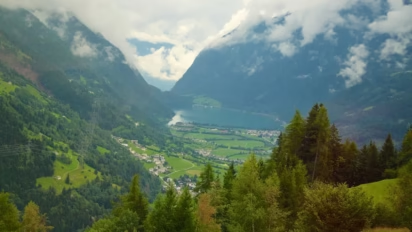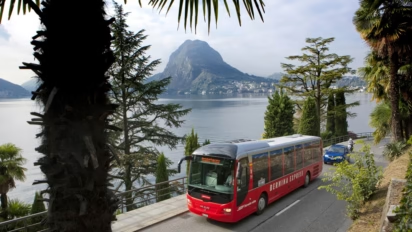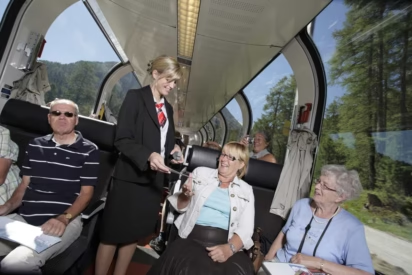The luxurious Bernina Express trains with panoramic windows travel through the Swiss Alps in Graubünden from Chur and St Moritz via Poschiavo to Tirano in Italy.
The Bernina Express trains cross the Swiss Alps twice in Graubünden on the UNESCO-listed Albula and Bernina railways with 55 tunnels and 196 bridges. The luxury Bernina Express trains with panoramic window wagons connect Chur and St Moritz via the Albula valley and tunnel before making the highest regular railway crossing of the Swiss Alps without using tunnels on the way to Tirano in Italy. The Bernina Express Bus provides a useful connection to Lugano in Ticino. Budget travelers may save by using the regular Rhaetian Railways trains on the same tracks. From Davos, use regional trains to connect with the Bernina Express in Filisur. From Milan, book day-trip tours that include travel on the Bernina Express trains, while many options are also available for tours from within Switzerland.
UNESCO-Listed Albula & Bernina Railways in Switzerland
The railways used by the Bernina Express and other Rhätische Bahn trains are from the golden age of railway engineering. These civil engineering masterpieces were completed during the early 20th century in a way no railway would ever be built today.
On the 122 km of railroad from Thusis in Switzerland to Tirano in Italy, no fewer than 55 tunnels and 196 bridges are used. This part of the railway used by the Bernina Express and other Rhaetian Railway trains was inscribed on the UNESCO World Cultural Heritage list in 2008, as it “constitutes an outstanding technical, architectural and environmental ensemble and embodies architectural and civil engineering achievements, in harmony with the landscapes through which they pass.”
Bernina Express Alpine Passes
This railway line crosses the Alps through two passes:
- The Albula line, completed in 1904, uses 42 tunnels and 144 viaducts and bridges on the 67 km route from north of the Alps to the Engadin Valley (Inn River). In the process, the trains make six almost circular turns – mostly inside tunnels carved into the rock face of the steep valley – and endless switchbacks to climb 400 m in altitude over a distance of around 12 km from Bergün to Preda. A final nearly 6 km tunnel sees the trains emerge into the Upper Engadin.
- The Bernina Line was completed in 1910. In 61 km, 13 covered galleries and 52 viaducts and bridges allow regular trains to pass through the 2253 m high Bernina pass before descending 1140 m in less than 20 km to Poschiavo. The line terminates in the Italian town of Tirano after the spectacular circular viaduct at Bruscio, where the train makes a full circle to climb the maximum in the smallest space possible.
En route, the Bernina Express trains literally pass glaciers and snow en route to the palm trees of Italy (and Lugano if continuing the journey on the Bernina Express bus to Ticino in southern Switzerland).
Travel on the Bernina Express in the Swiss Alps

The Bernina Express trains with luxury wagons featuring panoramic windows operate year-round, although the operating and reservation systems differ between summer and winter. (Regular regional express trains run far more frequently year-round on the same tracks at standard prices.)
The Bernina Express trains use two basic routings during summer:
- Chur via Thusis and Filisur to Tirano – 4 hours — the main routing that runs at least once per day year-round
- St Moritz to Tirano – 2.5 hours
(The former Landquart via Klostsers and Davos Platz to Tirano routing is not currently in operation. Use local trains to connect either at Chur or Filisur with the Bernina Express trains.)
In summer, early May to late October, trains to and from St Moritz run three times per day in each direction and usually twice per day from Chur. Expensive reservations prior to boarding are obligatory.
In winter, one daily Bernina Express train connects Chur and Tirano in each direction. Travelers from St Moritz may join the Bernina Express at Pontresina and from Davos at Filisur.
Bernina Express Obligatory Reservation Fees
In 2025, the reservation fee for travel on the Bernina Express trains depends on the route traveled:
- If traveling only on the stretch between St Moritz and Tirano (or v.v.) the seat reservation is CHF28 all year.
- If traveling the longer route between Chur and Tirano, the reservation is CHF36 from 15 May 2025 to 26 October 2025, and CHF32 for the rest of the year.
The reservation fees for Bernina Express seats are the same whether traveling first or second class. Similarly, the reservation charge is not discounted for passes or children.
The “express” in Bernina Express refers to the limited number of stops that the trains make – regular regional trains use the same tracks but stop more frequently.
The exact stations at which the Bernina Express stops depend on the specific train. All trains stop at Poschiavo at the lower reaches of the valley and most stop at Alp Grüm, Ospizio Bernina, Pontresina, and St. Moritz.
Bernina Express Bus to Lugano
From Tirano, the special Bernina Express Bus provides a majestic three-hour journey via the Veltlin (Valtellina) Valley and the shores of Lake Como to Lugano in Ticino (Tessin), Switzerland’s only Italian-speaking canton. The bus runs once per day from early April to late October, and on Thursdays and weekends from mid-February to mid-November.
The Bernina Express Bus may be taken independently from using the Bernina Express trains and requires a separate reservation.
In 2025, the Bernina Express Bus fare is around CHF41 plus CHF14 (CHF16 in the high season) reservation fee.
Day-trip tours from Milan are often available for travel by Bernina Express and returning to Milan by bus.
Tickets for the Bernina Express Train
The price of tickets for the Bernina Express trains is the same as for regular regional trains operating on the same tracks. However, seat reservations are essential for using the panoramic cars of the Bernina Express.
Seat reservations are obligatory for traveling on the Bernina Express. The reservation fee is per seat irrespective of class or distance traveled. No discounts for children or any rail pass bearers. As a result, the Bernina Express is best used on longer journeys and regular Rhätische Bahn trains for shorter rides.
Sample fares without the reservation fee for the Bernina Express in second class (first class) in 2025 are:
- Chur to Tirano – CHF66 (CHF113)
- St Moritz to Tirano – CHF33 (CHF57)
- Tirano to Lugano by bus – CHF34
Travel to Poschiavo is around CHF8 (CHF12) cheaper
Return fares are simply double single tickets. Children 6 to 16 pay half the regular fare but if traveling with parents or grandparents, a Junior Card may be far better value.
→ See also Bernina Express Train Tickets Saving Tips and Cheap Discount Deals for tips on how to save on the fare.
More on Panoramic Train Journeys in Switzerland
- Best Luxury Panorama Express Trains in Switzerland
- Travel on the Glacier Express for more details on the slowest express train in the world.
- Saving Tips for Traveling on the Glacier Express Trains — book early.
- Travel on the Bernina Express – from the glaciers of Graubünden to the palm trees of Italy and Lugano.
- Savings Tips for Traveling on the Bernina Express Train
- Jungfraujoch – Top of Europe — Highest train station in the Alps. Now also partly possible by Eiger Express cable car.
- Golden Pass Trains from Montreux via Interlaken to Lucern. Luxury Golden Pass Express trains require no reservation surcharge.
- Buy train tickets through Rail Europe or easy-to-use Trainline.
- Eurail, Interrail, and Swiss Travel passes are valid on the Glacier and Bernina Express trains obligatory seat reservations are extra.
- Book tours and combination deals on the Bernina Express.

